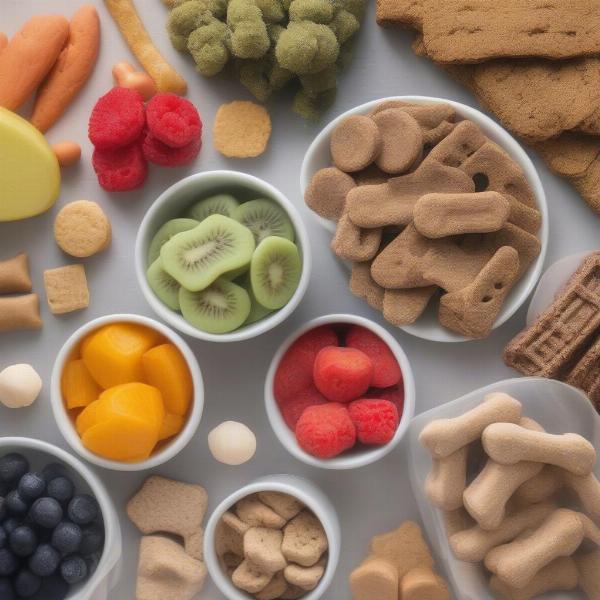A dog eating a whole loaf of bread might seem comical, but it can actually cause a range of health problems. While a small amount of plain bread isn’t toxic, a large quantity can lead to digestive upset, obesity, and even more serious issues like pancreatitis. This article will explore the potential dangers of dogs consuming excessive amounts of bread, explain what to do if your dog eats a loaf of bread, and suggest healthier alternatives for treating your canine companion.
Bread, particularly white bread, offers little nutritional value for dogs. It’s primarily composed of carbohydrates, which can contribute to weight gain and spike blood sugar levels. Furthermore, many breads contain added sugars, salt, and preservatives, none of which are beneficial for your dog’s health. Certain types of bread, such as raisin bread, are extremely dangerous and should never be given to dogs due to the toxic effects of raisins. If your dog has consumed a large amount of any type of bread, it’s crucial to monitor them closely and contact your veterinarian if you notice any unusual symptoms.
Why is Bread Bad for Dogs?
While a small piece of plain bread won’t harm your dog, a whole loaf can. Here’s why:
- Digestive Upset: A large amount of bread can cause gas, bloating, and diarrhea in dogs. This is because their digestive systems aren’t designed to process large quantities of carbohydrates efficiently.
- Obesity: Bread is high in calories and low in nutrients. Regular consumption, especially in large quantities, can contribute to weight gain and obesity, leading to various health problems.
- Pancreatitis: Rich, fatty breads, or large amounts of any bread, can trigger pancreatitis, a serious and potentially life-threatening inflammation of the pancreas.
- Toxic Ingredients: Some breads contain ingredients that are toxic to dogs, like raisins, xylitol (an artificial sweetener), garlic, and onion powder. Always check the ingredient list before giving your dog any human food.
What to Do if Your Dog Eats a Loaf of Bread
If your dog eats an entire loaf of bread, follow these steps:
- Assess the situation: Determine what kind of bread it was and how much they consumed. If it contained toxic ingredients like raisins or xylitol, contact your veterinarian immediately.
- Monitor for symptoms: Watch for signs of digestive upset such as vomiting, diarrhea, gas, bloating, loss of appetite, or lethargy.
- Contact your vet: If your dog exhibits any of these symptoms, or if you are concerned about the amount of bread consumed, contact your veterinarian for advice. They may recommend inducing vomiting or other treatments depending on the situation.
- Prevent future incidents: Store bread and other human foods securely out of your dog’s reach.
Healthy Alternatives to Bread for Dogs
Instead of giving your dog bread, opt for healthier treats that are specifically designed for canine consumption. These include:
- Dog biscuits and treats: Choose treats that are low in fat and sugar and made with wholesome ingredients.
- Fruits and vegetables: Offer small pieces of dog-safe fruits and vegetables like apples (without core and seeds), carrots, or blueberries. meat cake for dogs can be a good alternative as well.
- Chew toys: Provide appropriate chew toys to keep your dog entertained and satisfied.
 Healthy Dog Treats
Healthy Dog Treats
Conclusion
While a small amount of plain bread is unlikely to cause serious harm, a dog ate whole loaf of bread can lead to several health issues. Always monitor your dog closely and consult your veterinarian if you suspect they’ve ingested a large amount or a dangerous type of bread, like dog ate raisin bread. Choose healthy alternatives and prioritize a balanced diet to keep your canine companion happy and healthy. Remember, if you’re ever unsure about what is safe for your dog to eat, it’s always best to err on the side of caution and contact your veterinarian.
FAQ
- Is it ok for my dog to eat a small piece of bread? A small piece of plain bread is unlikely to cause harm, but it shouldn’t be a regular part of your dog’s diet.
- What should I do if my dog ate raisin bread? Contact your veterinarian immediately, as raisins are toxic to dogs.
- Can bread cause pancreatitis in dogs? Yes, especially rich, fatty breads, or large amounts of any kind of bread, can trigger pancreatitis.
- What are some healthy alternatives to bread for dogs? Dog biscuits, dog-safe fruits and vegetables, and chew toys are good alternatives.
- Why is white bread bad for dogs? White bread is high in carbohydrates and low in nutrients, contributing to weight gain and potential blood sugar spikes.
- What are the signs of digestive upset in dogs? Vomiting, diarrhea, gas, bloating, loss of appetite, and lethargy.
- How can I prevent my dog from eating bread? Store bread and other human foods securely out of their reach.
ILM Dog is your trusted partner in pet care, offering expert advice on everything from breed selection and health to training and nutrition. Whether you’re a seasoned dog owner or just starting out, we provide valuable resources and support to help you give your furry friend the best life possible. We specialize in Dog Breeds and Selection, Dog Health and Medical Care, Dog Training and Behavior, Dog Nutrition and Feeding, and Dog Products and Accessories. For further information and personalized guidance, please don’t hesitate to contact us at [email protected] or call us at +44 20-3965-8624. ILM Dog is here to help you every step of the way.